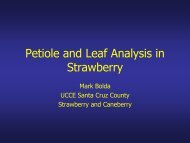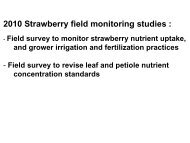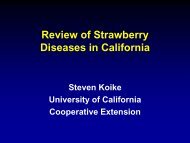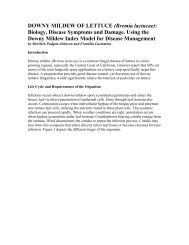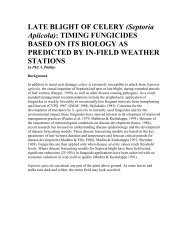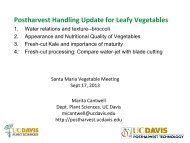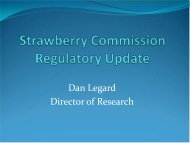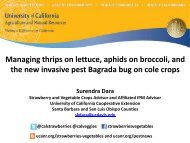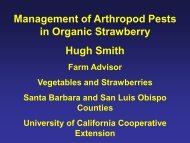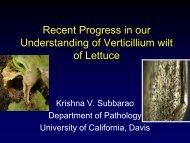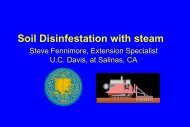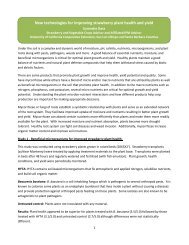California Strawberry Commission 2012 Lygus Research Summary
California Strawberry Commission 2012 Lygus Research Summary
California Strawberry Commission 2012 Lygus Research Summary
Create successful ePaper yourself
Turn your PDF publications into a flip-book with our unique Google optimized e-Paper software.
<strong>California</strong> <strong>Strawberry</strong> <strong>Commission</strong><br />
<strong>2012</strong> <strong>Lygus</strong> <strong>Research</strong> <strong>Summary</strong><br />
Hillary Q. Thomas & Elizabeth Church<br />
<strong>California</strong> <strong>Strawberry</strong> <strong>Commission</strong><br />
hthomas@calstrawberry.org
Update on new spray materials<br />
Material<br />
Active<br />
Ingredient<br />
Mode of<br />
Action IRAC Update<br />
Beleaf<br />
Flonicamid<br />
Feeding<br />
blocker<br />
9C<br />
Was available for Oct<br />
<strong>2012</strong>; expected May-<br />
June 2013<br />
Belay Chlothianadin Neonicotinoid 4A<br />
Bexar* Tolfenpyrad METI 21A Spray trial data<br />
Closer* Sulfoxaflor Sulfoxaflor 4C Spray trial data
<strong>Lygus</strong> Spray Trial<br />
• Guadalupe trial sprayed on 8/29 and 9/12/12<br />
• Watsonville trial sprayed 10/5 and 10/12/12<br />
• 0.08 acres/plot, 1/3 acre per treatment, 4 reps
Guadalupe Spray Trial<br />
Preliminary Results – Adult <strong>Lygus</strong><br />
Bexar<br />
Closer<br />
Control<br />
Average<br />
<strong>Lygus</strong> per<br />
20 plants<br />
(N=4)<br />
Significantly less <strong>Lygus</strong> adults, large nymphs and small nymphs in Closer treatment<br />
~ 56% average reduction in culled fruit
Spray Trial<br />
Preliminary Results – <strong>Lygus</strong> Large<br />
Nymphs<br />
Bexar<br />
Closer<br />
Control
Spray Trial<br />
Preliminary Results - Thrips<br />
Guadalupe Trial<br />
A<br />
A<br />
B
Spray Trial<br />
Preliminary Results<br />
• Closer may be a more promising <strong>Lygus</strong> material<br />
• Bexar may be a more promising thrips material<br />
• Marketable yield was increased in both trials<br />
Guadalupe Trial<br />
Fruit Evaluation (N=4)<br />
Watsonville Trial<br />
10/19 Fruit Evaluation (N=4)
<strong>2012</strong> Program<br />
Monitoring Program<br />
• 28 Scouts trained early season<br />
(March-April)<br />
• Santa Maria<br />
• Salinas/Watsonville<br />
• 20 participants continued through<br />
season (72%)<br />
Bioassays<br />
• Tested 26 fields (1 st and 2 nd year fields)<br />
• 24 were program participants<br />
• + End of season and beginning of season<br />
• + Paired second year and first year fields<br />
• Commonly used pesticides and tank<br />
mixes<br />
• Watsonville-Salinas and Santa Maria-<br />
Guadalupe<br />
Grower Surveys<br />
Pre and post-season
Grower Surveys<br />
• <strong>Lygus</strong> is the most important insect pest problem for this industry; 63% of<br />
respondents replied that their program improved this year.<br />
• Successful management: low pressure, monitoring<br />
• Unsucessful high pressure, low efficacy of spray materials<br />
• Second year neighboring berries were ranked as the most important<br />
source of <strong>Lygus</strong> moving into first year fields<br />
• Almost 89% of growers have some form of an IPM program: 74% rotate<br />
crops; 100% rotate chemicals<br />
• Vacuums were used by 53% of respondents, those who vacuum rank it<br />
highly valuable (4.3/5)<br />
• 84% would support restrictions on second year production
Avg count per 20 plant sample<br />
Avg count per 20 plant sample<br />
Monitoring Data --1 st year fields with no 2 nd year adjacent<br />
10 Avg Adults<br />
9 Avg Large Nymphs<br />
Avg Small Nymphs<br />
8<br />
7<br />
6<br />
5<br />
4<br />
3<br />
2<br />
1<br />
0<br />
6/8 Malathion<br />
(thrips)<br />
6/15 Assail<br />
6/22 Brigade<br />
6/29 Neemix<br />
7/18 Bifenture<br />
8/10 Malathion+<br />
Evergreen<br />
7/31 Evergreen<br />
8/24 Actara+<br />
Malathion<br />
10<br />
9<br />
8<br />
7<br />
6<br />
5<br />
4<br />
3<br />
2<br />
1<br />
0<br />
Avg Adults<br />
Avg Large Nymphs<br />
Avg Small Nymphs<br />
6/13 Rimon<br />
7/27 Rimon<br />
Site 27<br />
Site 4
Avg count per 20 plant sample<br />
1 st year field with 2 nd year adjacency with no vacuuming<br />
40<br />
35<br />
30<br />
25<br />
Avg Adults<br />
Avg Large Nymphs<br />
Avg Small Nymphs<br />
1/30 Lorsban<br />
3/31 Rimon<br />
7/16 Dibrom+<br />
Malathion<br />
7/3 Actara+<br />
Danitol<br />
8/27 Dibrom+<br />
Malathion<br />
8/13 Dibrom+<br />
Malathion<br />
7/31 Bifenture+<br />
Malathion<br />
8/6 Malathion<br />
9/3 Dibrom<br />
20<br />
15<br />
10<br />
4/6 Actara+<br />
Malathion<br />
5/22 Actara<br />
5/9 Rimon+<br />
Assail<br />
6/14 Dibrom+<br />
Malathion<br />
6/5 Malathion+<br />
Bifenture<br />
7/23 Rimon<br />
5<br />
0<br />
Site 3
Avg count per 20 plant sample<br />
Field with 2 nd year berries adjacent – with vacuum use<br />
30<br />
Avg Adults Avg Large Nymphs Avg Small Nymphs<br />
8/4 Actara+<br />
Malathion<br />
8/27 Dibrom<br />
25<br />
4/3 Rimon+Malathion<br />
20<br />
15<br />
10<br />
5/1 Malathion+<br />
Actara<br />
5/10 Dibrom<br />
5/18 Danitol+Rimon<br />
Assail<br />
6/8 Dibrom+<br />
Malathion<br />
7/6 Rimon+<br />
Actara<br />
7/12 Assail+<br />
Pyganic<br />
8/31 Actara+<br />
Rimon<br />
5<br />
0<br />
Site 22
% Mortality<br />
% Mortality<br />
5/1/<strong>2012</strong><br />
5/1/<strong>2012</strong><br />
6/4/<strong>2012</strong><br />
6/4/<strong>2012</strong><br />
5/15/<strong>2012</strong><br />
4/24/<strong>2012</strong><br />
8/15/<strong>2012</strong><br />
5/15/<strong>2012</strong><br />
9/5/<strong>2012</strong><br />
8/15/<strong>2012</strong><br />
8/15/<strong>2012</strong><br />
9/5/<strong>2012</strong><br />
8/9/<strong>2012</strong><br />
8/15/<strong>2012</strong><br />
6/19/<strong>2012</strong><br />
4/10/<strong>2012</strong><br />
5/22/<strong>2012</strong><br />
8/9/<strong>2012</strong><br />
4/24/<strong>2012</strong><br />
6/19/<strong>2012</strong><br />
Resistance results<br />
5/22/<strong>2012</strong><br />
5/30/<strong>2012</strong><br />
4/24/<strong>2012</strong><br />
8/1/<strong>2012</strong><br />
5/30/<strong>2012</strong><br />
5/2/<strong>2012</strong><br />
8/1/<strong>2012</strong><br />
4/24/<strong>2012</strong><br />
5/2/<strong>2012</strong><br />
5/15/<strong>2012</strong><br />
5/15/<strong>2012</strong><br />
8/1/<strong>2012</strong><br />
8/1/<strong>2012</strong><br />
4/24/<strong>2012</strong><br />
7/25/<strong>2012</strong><br />
5/22/<strong>2012</strong><br />
4/24/<strong>2012</strong><br />
5/30/<strong>2012</strong><br />
5/22/<strong>2012</strong><br />
8/1/<strong>2012</strong><br />
5/30/<strong>2012</strong><br />
8/27/<strong>2012</strong><br />
8/1/<strong>2012</strong><br />
8/29/<strong>2012</strong><br />
8/27/<strong>2012</strong><br />
5/15/<strong>2012</strong><br />
8/29/<strong>2012</strong><br />
7/30/<strong>2012</strong><br />
5/15/<strong>2012</strong><br />
8/13/<strong>2012</strong><br />
7/30/<strong>2012</strong><br />
5/30/<strong>2012</strong><br />
8/13/<strong>2012</strong><br />
5/12/<strong>2012</strong><br />
5/30/<strong>2012</strong><br />
5/12/<strong>2012</strong><br />
9/12/<strong>2012</strong><br />
9/12/<strong>2012</strong><br />
7/25/<strong>2012</strong><br />
5/2/<strong>2012</strong><br />
5/2/<strong>2012</strong><br />
100<br />
90<br />
80<br />
70<br />
60<br />
50<br />
40<br />
30<br />
20<br />
10<br />
0<br />
Malathion 1 st yr = 27.3% avg<br />
Malathion 2 nd yr = 29.5% avg<br />
Malathion 1st yr<br />
Malathion 2nd yr<br />
0 2 3 3 3 3 4 8 10 12 14 18 18 18 18B 21 21 6B 22 22 22 22 26 29 30 30 31 32 32 32 33<br />
100<br />
90<br />
80<br />
70<br />
60<br />
50<br />
40<br />
30<br />
20<br />
10<br />
0<br />
Malathion+Actara 1 st yr = 79.6% avg<br />
Malathion+Actara 2 nd yr = 87.8% avg<br />
Malathion+Actara 1st yr<br />
Malathion+Actara 2nd yr<br />
0 2 3 3 3 4 10 12 14 18 18 18 18B 21 21 21 22 22 22 22 26 29 30 30 31 32 32 32 6B 33
<strong>Lygus</strong> Program Findings<br />
• Material efficacy was highly variable by location, likely due to<br />
history of use<br />
• Tank mixing improved materials but does it reduce overall<br />
pesticide use?<br />
• Some participating fields that vacuumed had fewer problems<br />
with management of large nymphs and adults in-field<br />
• We do not currently have a cohesive IPM strategy for <strong>Lygus</strong> bug<br />
• Changes in labor and production practices may shape area-wide<br />
Integrated Pest Management programs for <strong>Lygus</strong> and other pests
Acknowledgments<br />
• Participating growers and grower cooperators<br />
• Surendra Dara, UCCE<br />
• Mark Bolda, UCCE<br />
• Nichino America Inc.<br />
• Dow



